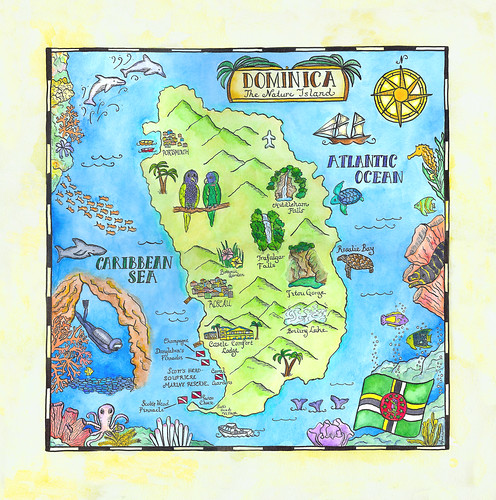
Geography: Dominica is an island, located in the Caribbean, between the Caribbean Sea and the North Atlantic Ocean, about half way between Puerto Rico and Trinidad and Tobago
Currency: East Caribbean Dollar (XCD)
National Symbol: Sisserou Parrot
National Anthem: "Isle of Beauty, Isle of Slendor"
Language: English
Area Comparison: Dominica is slightly more than four times the size of Washington, DC
Distance from Pittsburgh: 3,327km or 2068 miles
National Symbol: Sisserou Parrot
National Anthem: "Isle of Beauty, Isle of Slendor"
Language: English
Area Comparison: Dominica is slightly more than four times the size of Washington, DC
Distance from Pittsburgh: 3,327km or 2068 miles
Weather You Should Expect: Tropical rainforest and monsoon
Terrain: Rugged mountains of volcanic origin
Highest Point: Morne Diabiotins 1,447m
Weather You Should Expect: A tropical climate with heavy rainfall, moderated by Northeast Trade Winds
Average Temperature in January: Low of 68 and High of 84
Terrain: Rugged mountains of volcanic origin
Highest Point: Morne Diabiotins 1,447m
Weather You Should Expect: A tropical climate with heavy rainfall, moderated by Northeast Trade Winds
Average Temperature in January: Low of 68 and High of 84
What You Must See: Trafalgar Falls, Sisserou Parrot, Botanical Gardens
Historical Fact: Dominica was the last of the Caribbean islands to be colonized by Europeans due chiefly to the fierce resistance of the native Caribs.
Science Trivia: Roseau sits on an alluvial fan formed hundreds of years ago. The river meandered across the area from Newtown to its current location.
Interesting Fact: Dominica is known as "The Nature Island of the Caribbean" due to its spectacular, lush, and varied flora and fauna, which are protected by an extensive natural park system. Also it is the most mountainous of the Lesser Antilles, its volcanic peaks are cones of lava craters and include Boiling Lake, the second-largest, thermally active lake in the world!
Fun Fact: Scenes for "Pirates of the Caribbean" 2 and 3 were shot on Dominica
Everything You Need to Know About the Flag:
It's green, with a centered cross of three equal bands - the vertical part is yellow (hoist side), black, and white and the horizontal part is yellow (top), black, and white. Superimposed in the center of the cross is a red disk bearing a Sisserou parrot, unique to Dominica, encircled by 10 green, five-pointed stars edged in yellow. The 10 stars represent the 10 administrative divisions (parishes). Green symbolizes the island's lush vegetation. The triple-colored cross represents the Christian Trinity. The yellow color denotes sunshine, the main agricultural products (citrus and bananas), and the native Carib Indians. Black is for the rich soil and the African heritage of most citizens. Whereas, white signifies rivers, waterfalls, and the purity of aspirations. Finally, the red disc stands for social justice.

No comments:
Post a Comment